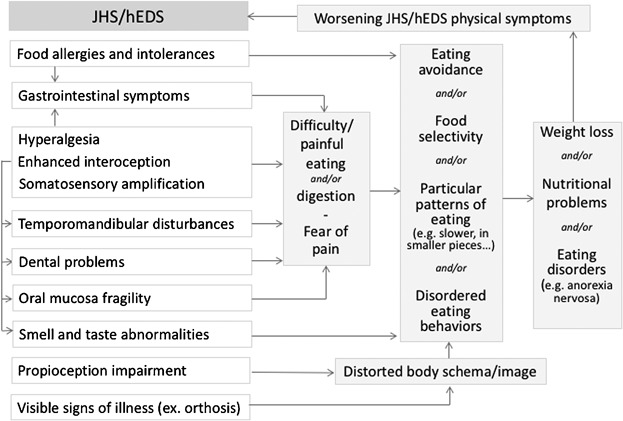|
Audio Version
Getting your Trinity Audio player ready...
|
May is EDS Awareness Month. Considered a so-called rare hereditary disease, it actually affects more than 17 million Europeans, but is unknown or at best misunderstood by most physicians, and this leads many patients to embark on a medical odyssey in their quest for understanding that can last an average of 22 years.
The Ehlers Danlos Syndrome confusion
The disease is often confused with other pathologies, such as fibromyalgia, Crohn’s disease, multiple sclerosis, asthma or even parental violence towards children, and this can have a deleterious effect on patients who are given treatments, examinations and even surgeries that are contraindicated or even dangerous.
The peculiarity of Ehlers Danlos Syndrome is that it can go completely unnoticed, or it can manifest in very different ways, even within the same family, which leads doctors to sometimes minimize the pain of these patients, and those around sufferers to view them as hypochondriacs.
This is certainly something that the people with whom I have discussed this disease share in common.
Laetitia’s story with EDS
“Ever since I was little, I have always had something. ‘A delicate flower’, as they say. My mother used to give me a name in French meaning that when I don’t have pain in the eye, I have pain in the arse!” jokes Laetitia.
How Laetitia got diagnosed with Ehlers Danlos Syndrome
“I got diagnosed in October 2020.
The journey until then had been long… I was forever going from one specialist to another… the rheumatologist, the neurologist and many others.
My constant aches and ‘accidents’ were put down to my being clumsy. Although getting a diagnosis didn’t help as such, knowing my condition had a name was a relief.
The first signs of EDS for Laetitia
In my case, EDS began to manifest itself at a very young age. I often dislocated my shoulder without doing anything special… sometimes just trying to grab something from a top shelf!
And then I realised that I have always been very flexible. I can do some pretty crazy things with my hands and fingers. In fact, in my family a lot of us are able to twist our little finger like this.
Plus, since I also have an autoimmune disease, it’s difficult to tell the difference between symptoms of EDS and those of the autoimmune condition”.
Why are there so many symptoms with this illness?
Ehlers Danlos Syndrome is indeed a genetic disease that is transmitted to at least half of children. It is due to a genetic mutation in collagen, found in our connective tissue, which is in 80% of our body. This means that the symptoms can manifest themselves in different organs and parts of the body.
However, for the hypermobile type, there is as yet no genetic test to confirm the diagnosis, which remains clinical.
Other clear symptoms of EDS
“I also have very stretchy skin and my daughter, who also has the syndrome, can do the splits without a problem.
In my case, the pain is mostly located in the upper body: shoulders, hands, and head. I have severe migraines for long periods of time.
I have also had problems with irritable bowels, difficulty regulating my temperature, and vagal discomfort, which are all signs of this syndrome.
In fact, there are so many symptoms that it’s easy to think it’s something else.”


How Laetitia manages her EDS
“To this day, I try to adapt my daily life to the syndrome, listen to my body and accept that I can no longer do certain things as I used to.
In Barcelona, it is my family doctor, the “doctora de cabecera”, at my local health centre who listened to me and did not hesitate to refer me and go beyond the protocols.
The doctor that diagnosed me was a rheumatologist at the Dexeus Clinic.
I am also seen by a neurologist at the Plato hospital.
The Icatme at the Dexeus helps my daughter and I to walk.”
EDS and orthotics
“We buy our orthotics and insoles from the Instituto Tecnico Ortopedico.
I did rehabilitation at the Hospital Clínic, where I met a great Doc “Núria” who, on seeing that the orthoses I was wearing were not right for my hands, gave me a “PAO” (prescription) and thus the payment was covered up to 85% by Spanish social security.
And to relieve my discomfort, I go to an acupuncturist here in Barcelona.”
Ehlers Danlos patients are often referred to as “Robocops” because of the many orthotics they have to wear to relieve the pain.
Plantar orthotics, or for the hands, knees, shoulders, neck … Another person who wishes to remain anonymous and who we will call Eve, also knows this situation all too well.
Eve’s story with EDS / HSD
She has lived in Barcelona for many years and was finally diagnosed after 25 years of going from one doctor to another. She was initially diagnosed with HSD (Hypermobility Spectrum Disorder), then EDSh. These two conditions are actually difficult to differentiate.
Some scientists even think it’s the same illness. A Spanish association for EDS explains that rheumatologists have a tendency to diagnose HSD while geneticists usually diagnose EDSh.
Eve’s EDS symptoms throughout her life
“It started with flat feet and scoliosis when I was a kid. But with the physiotherapy sessions and orthopaedic shoes, I had a rather peaceful childhood, even though I had some dislocations… but I never thought it was related to one and the same issue. I only thought it was bad luck…
When I was a teenager, I started to have severe pain in my feet, preventing me from being able to walk or stand for more than an hour a day. It was very disabling, but most people couldn’t understand why I was in pain. The doctors told me I was too young to have so many problems. Friends couldn’t understand why I couldn’t keep up when we went out or when we went on vacation together: I couldn’t stand up for very long …
After an operation that left me with lifelong consequences, I lost confidence in doctors and decided not to tell anyone about my pain again, either to doctors or to friends, as I thought like that it would be easier to integrate socially. I decided to act as if nothing was wrong, and just try and avoid standing. People who didn’t know me well didn’t understand… My close friends saw that I had a problem, but some thought I was hypochondriac, or a serial moaner (“My feet hurt, can’t we sit down?” “I’m cold, I’m hot…”). “
People with EDS indeed have problems regulating body temperature. This can result in cold extremities, sweating or hot flashes…
When signs of EDS start to appear clearly for Eve
“I have always had digestive problems, right from birth.
But since 2012, I have had a problem that has manifested itself almost every year!
A locked back, frequent blackouts (related to body temperature regulation issues and tiredness), major digestive problems, repeated sprains, unexplained bruises and so on…


In 2019, we discovered many dislocations all around my body that I couldn’t explain as I hadn’t fallen. This is when my rheumatologist said that we couldn’t blame it all on the fibromyalgia he had first diagnosed me with. But he was not fully familiar with EDS and failed to mention it.”


How Eve finally got diagnosed
“It was my podiatrist in France who first told me about EDS in 2019.
He asked me questions which I found quite bizarre, such as: “Do clothing labels bother you?” Or: “Do you often bash into door frames?”. It made me laugh because I do, all the time, and people ask me if I’ve got my eyes open when I walk.
This is called the door sign, a problem with proprioception, a very common symptom in people with EDS”.
EDS : an invisible disability
May is also the month we celebrate Labor Day, and there is still a lot to be done to include people with disabilities. The three people interviewed had a somewhat similar story to tell at this level.
“Having an invisible disability doesn’t make it any easier either. People may think we are pretending or exaggerating. Even if everyone knows not to judge a book by its cover, a young woman who does not give up her seat on the bus to a pregnant woman or an elderly person risks being insulted, because her illness is not visible”.
This has happened to Eve several times on the bus, as she is unable to stand for more than 5 minutes without having tremendous pain.
EDS and disability recognition
These people are often ignored, especially in Spain. And their disability is rarely recognized. They are not entitled to a wheelchair or to a disability card, even if they are limited to walking for even a few minutes a day.
Laetitia has no disability recognition here in Spain, despite all the sick leaves caused by EDS. Eve, on the other hand, explains that for a long time she rejected the idea of applying for a disability card; but when she lost her job in 2018 due to discrimination based on her disability, she decided to apply. The degree of disability recognised does not match her reality, but it is already a step forward in allowing her to have better access to transport in Barcelona, for example, or to small discounts in certain physiotherapy centres.
Magali’s story
Magali explains that it was primarily her knees that suffered from this disease.
“I got my diagnosis in 2003, when I was due to have surgery for the second time on my left knee.
My sister, who has EDS, had also encountered a neurologist who suggested Ehlers Danlos Syndrome. I told this to my surgeon, who preferred to put off surgery until the diagnosis was final.
Living in Paris at the time, I was referred to Professor H. and then to the Georges Pompidou European Hospital to do lots of tests. The verdict came back: EDS hypermobile type. The surgeon decided to cancel the knee surgery”.
Professor H. is one of the most qualified doctors in this disease in Europe, and Eve had also been referred to him by the podiatrist who followed her until 2019 in France.
Magali’s journey before the diagnosis
“I had a lot of sprains and unexplained pain. I was also an excellent gymnast due to my hyperlax body : I can still do the splits without warming up at 47. It always amazes people!
I ended up saying to myself, “Well, this is you, this is how you’re made, we’ll just have to deal with the pain, sprains and dislocations each time they occur without sounding like you’re crazy”.
There were a few signs that caught my attention before the diagnosis, like all these sprains and dislocations, but also because I got bruises for no reason.
Today, I make sure to lead a normal life, because I don’t want to suffer from the disease. I take morphine when the pain is too much or when my body tells me, “Mag, you’re kidding here, you’re going too far” and it nails me to my bed.
Magali’s EDS treatments and follow-ups
I prefer to continue my follow-up in Perpignan, even if it is a little more complicated to get there with the pandemic. But in France, it’s easier and I have a disability recognition.
Dr Michel E. has been seeing me for two years.
I used to go to Paris with Professor H. and Dr M., who is now in Nantes.
I have my physiotherapist Bruno B. in Perpignan, who has been with me for 18 years and who has been well informed about the EDS throughout this time. “
Advice to people who have been passed from doctor to doctor for years
I asked these three people what advice they would give to people who have been passed from doctor to doctor for years.
Magali replies: “I would tell them not to give up hope. Ehler Danlos syndrome is an orphan disease, yes, but the media and doctors are talking about it more and more. It’s even been talked about in TV series, much to my surprise!”
Laetitia adds:
“I would tell them not to let go but to insist. You know yourself and if you feel that there is a problem, do not hesitate to see different specialists”.
Eve, meanwhile, says she often thinks about her mother’s journey, who has never been diagnosed but has had major concerns that seem to be related to the condition. And although sometimes it’s been really hard, she has always managed to get back on her feet and find a solution to every problem. So we must not lose hope, even when we are at our worst.
Dr B., director of the HDS/EDS, Fibromyalgia and Chronic Fatigue Center for Diseases at Hospital del Mar in Barcelona, actually explained to Eve while he confirmed the diagnosis, that there is no medication for this disease. Each problem must be addressed with the appropriate specialist and the appropriate therapy.
EDS among famous people
There are also famous people who have this syndrome, such as the singer Sia. She published it in a Tweet in October 2019:
I’m suffering from chronic pain, a neurological disease, Ehlers Danlos and I just wanted to say to those of you suffering from pain, whether physical or emotional, I love you, keep going. Life is fucking hard. Pain is demoralizing, and you’re not alone.
— sia (@Sia) October 4, 2019
Cami Clune is a singer and actress. In 2020, she was on Season 19 of NBC’s The Voice where she spoke openly about her journey with EDS. She advocates for EDS whenever possible. For EDS Awareness Month, she is working with the EDS Society on a few things, including their “Zebra’s Got Talent” event. She is also part of a Facebook group for EDS. She explains how helpful this group is, in discussing symptoms and relating with others. She’s also offering her help to spread awareness with her platform.
Some celebrities – even among the greatest stars – have not been fortunate enough to be diagnosed. There are people who think that Michael Jackson may have had the condition, like both Scarlet Huissoud, a GP in Switzerland, and Professor Hamonet.
Why is EDS so difficult to diagnose?
Dr H. , one of the few general practitioners in France who knows about the disease, explains in a video why the diagnosis is so difficult for patients to obtain:
“In medical school, we are taught the description of Ehlers Danlos Syndrome.
A little bit of history: Dr Ehlers described in 1900 a true symptom of Ehlers Danlos and Dr Danlos who was a French dermatologist described in 1908 another case which he thought was identical to Mr Ehlers’, but he was mistaken. And Dr. Charles Miget in 1933 wrote his thesis and brought the two descriptions together for the first time by describing the disease and including Mr. Danlos’s mistake.
So what was Mr. Danlos’s mistake?
Mr. Danlos had described a patient with hyperlaxity, but who also had an elastic pseudo-symptom. It doesn’t matter. It’s a circus thing. You take an individual’s skin, you pull it, and it turns into a sling. He’s the circus artist. And that’s what the doctors remembered. All the doctors in France and beyond. Only a quarter of an hour has been devoted to Ehlers Danlos in over 10 years. Even though they were present that day, that they had been wide awake and listening and we tell them that people are hyperlax and we show them a slide with people who are circus artists, where their skin is pulled and they make scarves with it… that’s all they remembered! When I send my EDS patients to specialists, all the doctors in France start by grabbing their skin, pulling it this way and that, and then say “poor Mr. H., he’s a little stupid, you don’t have EDS!” And this is why the description of this disease has not been more widely shared. This disease has been redescribed by Professor Hamonet thoroughly, with a clinical diagnosis which is quite obvious when we know it”.
Why is EDS represented by a zebra?
EDS and other rare diseases are represented by a zebra. It looks like a horse, but it isn’t. “When you hear hoofbeats, think horses, not zebras” said Dr. Theodore Woodward, a professor at the University of Maryland, Baltimore School of Medicine in the 1940s.
This was a way of teaching medical students how to categorize common diseases (as horses) and rare diseases (as zebras, which are rather rare animals in the United States).
When you are on a medical odyssey that lasts years, you realize how important it is to know and raise awareness of this type of illness to help other patients and save them unnecessary setbacks.
Sharing information about EDS is the best way to help patients diagnosed or not yet diagnosed.
If you live in Spain, and speak Spanish, you can follow some NGOs like ANSEDH who shared this great video on their Facebook page. Don’t hesitate to share this article to help bring awareness to this invisible illness.


Awesome article. Very helpful to understand EDSis about!
Thank you, hopefully, it helps support people with this condition as well as their family and friends.
Thank you and hopefully, it helps supporting people with the condition as well as their friends and family.
The doctors don’t have answers. I have relapse remitting MS- I don’t take any medications for MS because I found they made me worse. When on the drug I became blind and paralyzed every 4 months like clockwork … I’d get better after a month or two and the cycle continued for years until I stopped taking their medications. And started on herbal tincture from Health Herbs Clinic I have not been paralyzed or blind since. I am a “walking miracle” because I barely suffer symptoms anymore. Natural Medicines, meditations and Ayurvedic therapies has helped me completely reverse my MS, I live a more productive life. Thank you for giving those of us with Multiple sclerosis a new hope.
Thank you for the tip. Was it an anti-epileptic that gave you the blindness? I just had a relapse or a “flare” as they call it, and the doctor told me to try a stronger medicine but honestly when I read the side effects, it’s pretty scary (one of them is also blindness…). I even asked him to tell me what they were, and he said it’s better I don’t read the side effect list… Obviously I am going to read it, because like you I am very sensitive to medicines and often allergic to them… He said he gives me such a low dose that it shouldn’t be a problem, but I am still skeptical. I might try herbal medicines instead like you did. I am so happy for you that it helped you control your MS. Cheers to that! I myself try to look for doctors who think more holistically at least. People who are open minded and understand that Mother Nature is sometimes if not more, as least as intelligent as Big Pharma…
Pingback: Is vegan food suitable for all? How to eat in a more sustainable way? - Planeta Sana®
Thanks for this great article! I’m sorry for your suffering, but I’m glad you received a proper diagnoses! Hopefully that has helped you find more effective ways to treat your specific issues and find knowledgeable and caring healthcare professionals. I recently received my diagnosis, this month, after 52 years of hell. I’ve had doctor after doctor not be able to diagnose what’s causing every system in my body to stop functioning, experienced injury after injury, been accused of having an eating disorder repeatedly, been told I have a mental disorder and even suggested that I have Munchausen’s syndrome (malingering, making myself sick/injuring myself). Now I finally have proof that it’s been hEDS all along, as well as genetic proof that I also suffer from Hereditary Alpha Tryptesemia (a Mast Cell Disorder).
It’s awful to be relieved to get two major diagnoses, but it has answered so many questions and has allowed my to feel very validated. I will never again hesitate to seek medical attention when I need to, as I have almost my entire life, due to healthcare personnel’s hesitancy to understand or suspect that I really just have psychiatric problems, or other other problems, or they have no clue why I’m as sick as I am! Thanks again for the article, EDS needs as much recognition as possible!
Thank you so much for supporting my work by adding your voice with this wonderful comment. I can completely relate. It’s tough to be told that you have a syndrome that has no cure, but it’s also a relief because you finally know what’s going on with you, you feel validated and at least you know you are not a hypochondriac. I wish you luck finding the right health professionals and help to be able to live at your best. I still meet doctors who tell me I don’t have EDS so now every time I visit a new doctor I bring the 3 letters I have from the 3 doctors who have confirmed the diagnosis. But the good thing is, more and more people speak about EDS now and little by little more doctors know about this condition. So hopefully we will be taken care of in a much better way than in the past. Don’t hesitate to reach out if needed, always happy to help the best way I can!